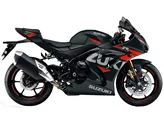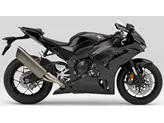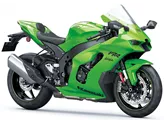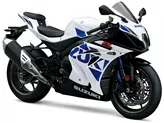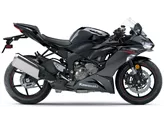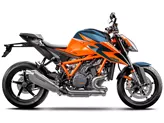Suzuki GSX-R 1000 2009 vs. Kawasaki Ninja ZX-10R 2010

Suzuki GSX-R 1000 2009

Kawasaki Ninja ZX-10R 2010
Vue d’ensemble - Suzuki GSX-R 1000 2009 vs Kawasaki Ninja ZX-10R 2010
The Suzuki GSX-R 1000 model year 2009 and the Kawasaki Ninja ZX-10R model year 2010 are both supersport motorcycles that offer high performance and advanced features. While they have some similarities in terms of engine type, displacement, and front and rear tire widths, there are also notable differences in their technical specifications.
Starting with the engine and drive train, both motorcycles have an inline four-cylinder engine, but the Suzuki GSX-R 1000 has a slightly smaller bore of 74.5 mm compared to the Kawasaki Ninja ZX-10R's 76 mm. The stroke of the Suzuki is 57.3 mm, while the Kawasaki has a stroke of 55 mm. In terms of power, the Kawasaki Ninja ZX-10R outshines the Suzuki GSX-R 1000 with 187 HP compared to 136 HP. However, the Suzuki has a higher torque of 116.7 Nm compared to the Kawasaki's 113 Nm. Both motorcycles have a compression ratio above 12, with the Kawasaki having a slightly higher ratio of 12.9.
In terms of suspension, both motorcycles offer adjustable compression and rebound settings for the front and rear suspension. However, the Suzuki GSX-R 1000 also offers preload adjustment, providing riders with more customization options. Both motorcycles have an aluminum frame, but the Suzuki has a twin-spar frame type, while the Kawasaki has an extruded frame type.

Suzuki GSX-R 1000 2009
When it comes to braking, both motorcycles have double disk front brakes with radial technology. However, the Kawasaki Ninja ZX-10R also features a petal design, which enhances heat dissipation and improves braking performance.
In terms of dimensions and weights, the Kawasaki Ninja ZX-10R has a slightly longer wheelbase of 1415 mm compared to the Suzuki GSX-R 1000's 1405 mm. The seat height of the Kawasaki is also higher at 830 mm compared to the Suzuki's 810 mm. The kerb weight of the Kawasaki is slightly heavier at 208 kg compared to the Suzuki's 203 kg. Both motorcycles have a similar fuel tank capacity, with the Suzuki having a slightly larger capacity at 17.5 liters compared to the Kawasaki's 17 liters.

Kawasaki Ninja ZX-10R 2010
In terms of strengths, the Suzuki GSX-R 1000 2009 offers improved geometry, a compact engine design, a relaxed seating position, a system with multiple height adjustments, and an anti-hopping clutch. On the other hand, the Kawasaki Ninja ZX-10R 2010 boasts extremely precise traction control, an efficient braking system, integrated electronics, a positive ABS system, and high engine power.
However, both motorcycles also have their weaknesses. The Suzuki GSX-R 1000 2009 has suboptimal accessibility of compression adjustment, is weak in the lower rev range, and is not recommended for beginners. The Kawasaki Ninja ZX-10R 2010 has a suboptimal transmission with tight gearshifts.
In conclusion, while both the Suzuki GSX-R 1000 2009 and the Kawasaki Ninja ZX-10R 2010 are powerful supersport motorcycles, they have distinct differences in their technical specifications and strengths. Riders should consider their individual preferences and riding style to determine which motorcycle would best suit their needs.
Caractéristiques techniques Suzuki GSX-R 1000 2009 par rapport à Kawasaki Ninja ZX-10R 2010
Avantages et inconvénients en comparaison
Avantages et inconvénients en comparaison
Suzuki GSX-R 1000 2009

Malgré une conduite précise et équilibrée et un déploiement de puissance maîtrisé, la GSX-R 1000 reste réservée aux pilotes expérimentés. Suzuki sait qu'un millier doit rester un millier et s'y tient strictement. Espérons qu'elle pourra le faire encore longtemps.
Kawasaki Ninja ZX-10R 2010

Les fans de Ninja n'ont pas d'autre choix que d'acheter la nouvelle 10. Elle est plus légère, plus puissante, plus souple et pourtant plus facile à piloter que n'importe quelle autre ZX-10R jusqu'à présent. La Kawa se présente également comme supérieure aux autres japonaises. Outre les motos européennes, les émotions, les préférences pour certaines couleurs et formes entrent certainement en jeu.
Comparaison des prix Prix moyen du marché Suzuki GSX-R 1000 vs Kawasaki Ninja ZX-10R
There are a few key differences between a Suzuki GSX-R 1000 2009 and a Kawasaki Ninja ZX-10R 2010. There are the same number of bikes of both models available on the 1000PS.de marketplace, specifically 6. It takes less time to sell a Kawasaki Ninja ZX-10R with 60 days compared to 64 days for the Suzuki GSX-R 1000. Since model year 2005 1000PS.de editors have written 71 reviews for the Suzuki GSX-R 1000 and 51 reviews for the Kawasaki Ninja ZX-10R since model year 2005. The first review for the Suzuki GSX-R 1000 was published on 3/3/2004 and now has more than 7,100 views. This compares to more than 2,900 views for the first review on Kawasaki Ninja ZX-10R published on 1/11/2004.





